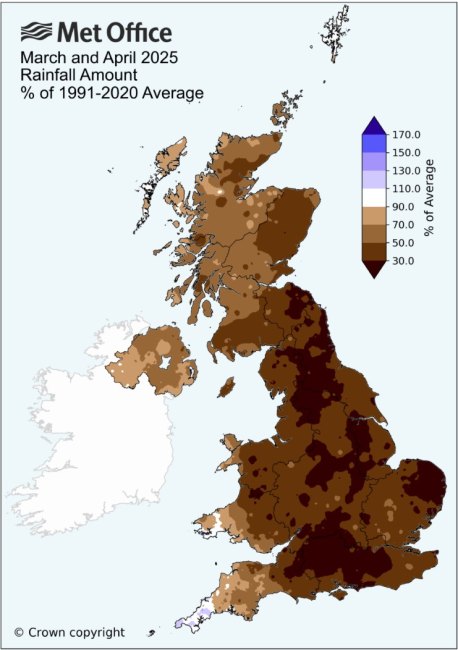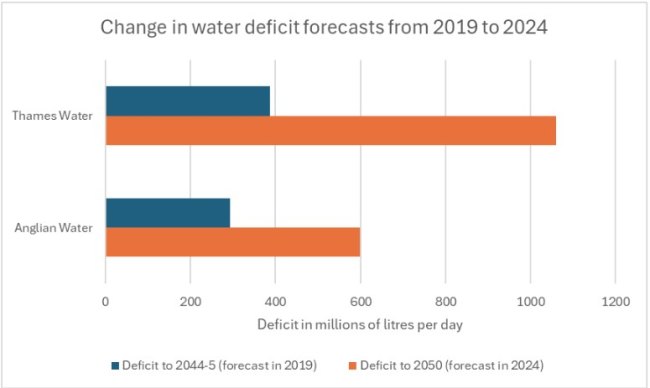Views
How water companies are preparing for a dry summer
A debate has started about whether the dry weather of recent months will have consequences for the country’s water security. Although some parts of the country saw some rain over the weekend, it is certain rainfall levels remain well below the long-term average. We have seen the driest March since 1961, and, in some areas, the driest March ever recorded. In April many areas had below half of expected rainfall levels, while we have also seen the hottest start to May ever recorded in the UK. In some regions those temperatures swiftly led to significant jumps in the level of demand. In some parts of the Republic of Ireland, dry conditions have already led to hosepipe bans.
Fig 1. Rainfall levels as a percentage of the long-term average, March-April 2025

Source: Met Office
We expect data over coming weeks to show that this combination of reduced rainfall and higher demand has started reducing water in the environment, making rivers and habitats more vulnerable and causing other problems (such as making it harder to use reservoir water to fight wildfires).
What action is the industry taking?
Water companies are taking action to ensure that as demand increases, we take no more water than we have to from rivers and groundwater sources. For example, over the last couple of weeks there has been a big increase in proactive water saving advice provided to customers (including new radio and TV adverts in some regions); surge teams of technicians have been deployed to fix leaks faster; and companies have been changing where they obtain water from, and moving it around regions differently, to relieve pressure on the hardest-hit sources.
The public may ask why, after a wet 2024 in central and southern England, do we not have enough water to tide us through this summer? Part of the answer is that we need more reservoirs to collect the rain when it falls. The good news is that, although in the past reservoirs have been blocked from construction, the industry now has clearance to deliver ten new reservoirs over the coming years, with the first already under construction at Havant Thicket near Portsmouth.
Analysis by Water UK (see chart below), shows that these will be more important than ever as over the last few years, the estimates of future water needs have dramatically increased for some parts of the country as government has accepted the need for greater drought preparedness. As a result, the two largest companies in England’s driest regions, Anglian Water and Thames Water, have over the last five years seen their estimated ‘water deficit’ (i.e. the gap between water supply and demand) grow by nearly a billion litres per day by 2050.
Fig 2. Estimates of future demand from 2019 and 2024 for the two largest companies in the east and south east of England

Source: Water UK analysis of Anglian Water and Thames Water’s Water Resources Management Plans for 2019 and 2024
How can we be better prepared in the future?
We need a better system to make sure we no longer see such wild swings in projections, or more new reservoirs being blocked. Water UK is calling (see section 3.3 here), for a new National Water Grid for England to drive through the construction of ten new reservoirs, one reservoir enlargement, nine desalination plants, seven water recycling schemes and multiple long distance transfer schemes to move water from wetter to drier areas. We want to move from a situation in which water companies are ‘running to keep up with demand’ to one in which everyone can be confident that the water will be there when they need it. We hope that the government will agree to implement this recommendation with urgency.
This week, Water UK and water companies will attend a meeting of the Environment Agency’s National Drought Group to discuss in detail the situation in each region and what further action can be taken to minimise impact on the environment.
In the meantime, we are encouraging everyone to think about their own water use so that we can leave more water for nature. You can find water saving tips here.




